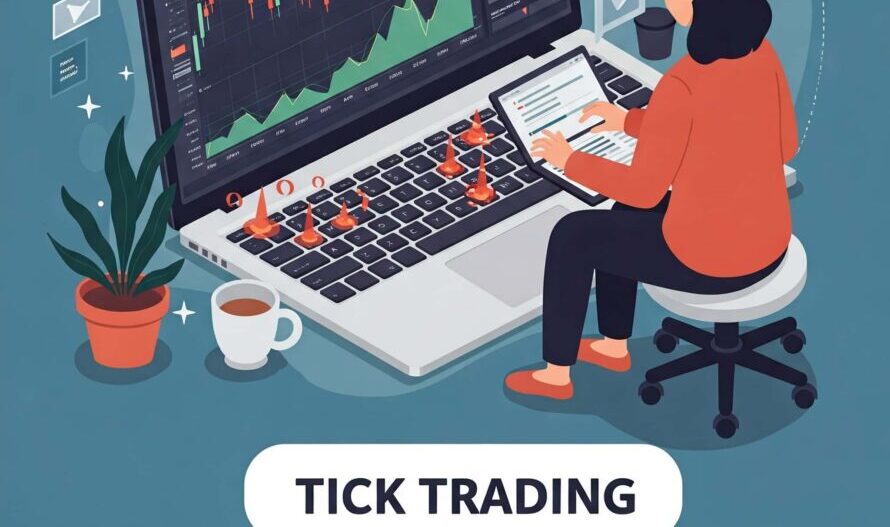
Key Highlights
- Tick trading capitalizes on minimal price fluctuations in financial markets.
- It demands a thorough understanding of market trends and swift execution.
- Tick size, the smallest price change allowed, significantly impacts this strategy.
- Traders utilize specialized software and charts to excel in tick trading.
- Risk management and emotional control are vital in this fast-paced method.
Introduction
In the fast-changing world of financial markets, traders always look for ways to gain an edge and improve their profits. Tick trading has become a popular method, attracting traders in the Indian stock market and elsewhere. This article will examine what tick trading is, why it matters, and how it works in the Indian stock market.
Understanding Tick Trading in the Indian Market
In the Indian stock market, tick trading is becoming very popular. This trading method focuses on quickly taking advantage of small price changes. It requires traders to have a clear understanding of market trends and to make fast decisions.
Day traders in India frequently use tick trading. They try to make trades and exit positions all in one day. They benefit from tiny price fluctuations throughout the trading session.
The Basic Concept of Tick Trading
Tick trading is a way to make money by focusing on small changes in price for a financial instrument. These small changes, known as “ticks,” represent the smallest price increment allowed. For example, if a stock has a tick size of ₹0.05, the price can go from ₹100 to ₹100.05 or ₹99.95, but it can’t change to ₹100.01.
The main idea of tick trading is to make many trades during a trading day to earn profits from these small movements. Imagine a trader buying a stock at ₹100 and placing a sell order at ₹100.05. When the price reaches ₹100.05, the trade happens, and the trader makes a small profit.
This process goes on, with traders taking advantage of small price swings consistently.
How Tick Trading Differs from Traditional Trading Methods
Tick trading is different from regular trading because it focuses on quick trade executions and a lot of trades. While traditional trading can last days, weeks, or even months, tick trading works in a much shorter time.
Tick trading aims to take advantage of small price differences. This often requires advanced tools and strategies so traders can spot and take profit opportunities. This is different from long-term investments that look at fundamental analysis and hold onto stocks for longer.
In simple terms, tick trading includes making many fast trades based on tiny price changes. Traditional trading, on the other hand, looks for bigger price fluctuations over a longer time.
The Importance of Tick Size in Tick Trading
Tick size is very important in tick trading. It determines the smallest price change a trader can use. This affects how often trades happen, how much profit can be made, and the overall trading strategy. Traders need to understand how different tick sizes work across various financial instruments.
A smaller tick size helps with precise entry and exit points. However, it may also increase transaction costs because it leads to more trades. On the other hand, a larger tick size can make it easier to see big market movements, but it might also limit the number of trading opportunities.
Defining Tick Size and Its Role in Financial Markets
Tick size is an important idea in financial markets. It is the smallest recognized change in price for a certain asset. Tick size helps with price movements and supports clear and fair trading.
This unit can change depending on the exchange and type of asset. It reflects how the market works and the rules in place. In liquid markets, like stocks that are traded a lot, tick sizes are usually smaller. This helps keep price differences tight and helps find prices quickly.
In contrast, less liquid markets or markets that have wild price changes often have larger tick sizes. This helps reduce big price swings and makes trading more stable.
The Impact of Tick Size on Trade Execution and Market Liquidity
Tick size plays an important role in how trades are done and how liquid the market is. When there is a smaller tick size, it usually leads to narrower bid-ask spreads. This means the gap between buying and selling prices gets smaller.
For traders, a tighter spread helps cut down on transaction costs and allows for faster execution. However, if the tick size is too small, it can create extra market noise. This noise makes it hard to tell real price trends from short-term changes.
On the flip side, a larger tick size can lower market noise. It helps in showing more significant price movements. Yet, a larger tick size could also mean wider spreads, which might increase transaction costs.
Examples of Tick Trading Strategies
Tick trading includes different strategies. Each one is designed to take advantage of certain market conditions and make money from small price changes. In the Indian stock market, two popular tick trading strategies are:
Strategy 1: Momentum Tick Trading
Momentum tick trading looks to make money from ongoing market trends. Traders watch closely for price movements and trading volumes to spot stocks with strong upward or downward momentum.
They aim to enter trades in the direction of the trend, taking advantage of the continued price changes. This strategy usually involves setting tight stop-loss orders to limit losses if the momentum changes direction.
The main goal is to get quick profits. Traders exit their positions as soon as the momentum starts to slow down.
Strategy 2: Reversal Tick Trading
Reversal tick trading does just what its name implies. It aims to spot possible price changes and make money from these shifts. Traders use this strategy by looking for signs that the market is slowing down or is either overbought or oversold. These signs may suggest a change in the trend of prices.
They may use tools like technical indicators, candlestick patterns, or market depth analysis to find these reversal points. Once they see a reversal, traders will buy or sell in the opposite direction of where the price was going before. This way, they hope to earn profits as the price adjusts.
Tick Charts and Their Application in Tick Trading
Tick charts are a unique way to show price movements. They only focus on the number of trades instead of set time periods. This special feature makes them great for tick traders. They give a detailed look at market activity. This helps traders spot small changes in supply and demand that might not show up on regular time-based charts.
Reading Tick Charts: A Beginner’s Guide
To read tick charts well, beginners should pay attention to these important points:
- Each bar or candlestick on a tick chart shows a set number of trades, not a specific time frame.
- The height of each bar or candlestick reflects the price range during those trades.
- Wider bars mean more volatility, while narrow bars show steadier price movements.
- By looking at patterns and trends on tick charts, traders can find possible entry and exit points.
Comparing Tick Charts with Time-Based Charts
Tick charts and time-based charts both offer important insights about the market. However, they serve different trading styles and goals.
Tick charts are best for high-frequency trading. They help traders see short-term price changes clearly by filtering out market noise. This makes them perfect for tick traders.
On the other hand, time-based charts work well for those who focus on longer trends and fundamental analysis. Here, the time factor matters more than the number of trades.
The Psychological Aspects of Tick Trading
Tick trading comes with special mental challenges because it happens quickly and needs fast decisions. Traders who want to do well in this situation need to develop certain mental skills to handle the pressure.
Decision Making in High-Frequency Tick Trading
Tick trading is very fast, so traders must make quick decisions under pressure. With lots of market data coming in, they need to act fast. If this isn’t managed well, it can result in hasty trading.
Successful tick traders usually make clear rules and strategies to help with their choices. They focus on objective analysis instead of letting emotions take over.
Managing Risks and Emotions in Tick Trading
In tick trading, managing risks is very important because trades happen often and losses can come quickly. To protect your money, it’s essential to use strong risk management strategies. This includes setting the right stop-loss orders and following specific rules for how big your positions should be. Doing this helps keep your capital safe and stops big losses.
Conclusion
In conclusion, tick trading is a special way to join the market. It focuses on small price movements. To do well in tick trading strategies, you need to understand tick size and how it affects your trades. Knowing how to read tick charts and handling psychological aspects like risk management and decision-making can help you use this method effectively. Whether you choose momentum or reversal tick trading, it is important to follow the tick size rules in the Indian market. Using tick trading tools and techniques can improve your trading skills and understanding of the market. Stay informed, stay smart, and explore the exciting world of tick trading.
Frequently Asked Questions
What Is the Minimum Tick Size Permitted in Indian Markets?
In India, the minimum tick size is set by the Securities and Exchange Board of India (SEBI). It changes depending on the type of security. For example, stocks on the National Stock Exchange (NSE) can have a tick size that is as low as ₹0.05.
Can Tick Trading Be Applied to All Financial Instruments?
Tick trading can work for any financial instrument that has a set tick size. However, it works best in highly liquid markets. These include stocks, futures, and forex. In these markets, price movements happen often, and the spreads are usually small.
How Do Tick Sizes Influence Trading Strategies?
Tick sizes affect trading strategies. They change transaction costs and how exactly you enter or exit trades. Smaller tick sizes usually help high-frequency methods like scalping. On the other hand, larger tick sizes may be better for trend-following strategies.
Are There Any Specific Software Tools for Tick Trading?
Specialized trading platforms are designed for tick traders. They provide features such as tick charts, Level II market data, and fast order execution. These tools help traders make quick trades based on small price fluctuations.







